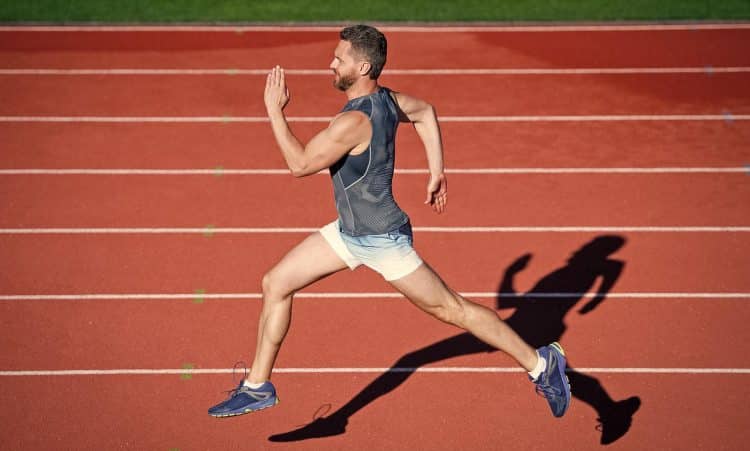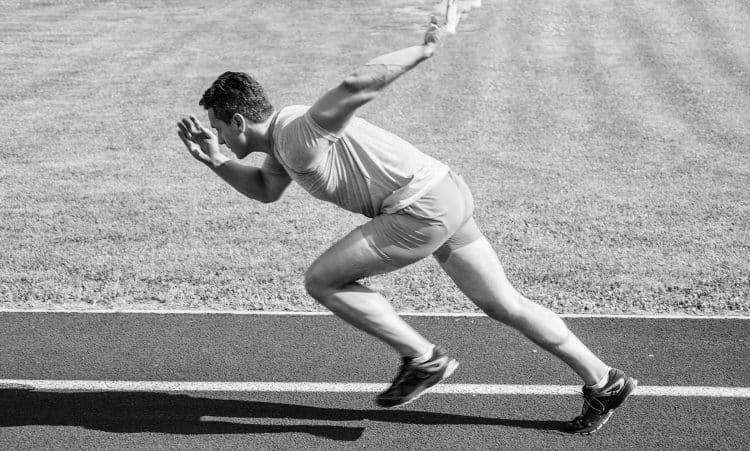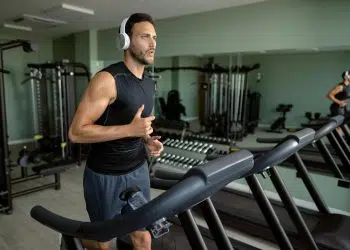Speed is a highly valued attribute in athletes. A fast sprint speed can be advantageous for playing football, baseball, hockey, basketball, or soccer. Furthermore, speed is non-negotiable in track and field events.
Running fast isn’t just about dashing as quickly as possible between two points. It can help you assess your body’s potential and limits. Training to improve your running speed can also help improve your pain threshold and ability to train close to mechanical failure.
In my early training days, I was intrigued about comparing my sprinting abilities to the average benchmark. This led me to explore the average human sprint speed and the intricacies of human physiology and performance. Understanding the average human sprint speed has allowed me to help my clients improve their overall physical performance.
In this article, we delve into everything that comprises average human sprint speed, the factors affecting sprint speed like age, gender, and training, and what the average human sprint speed can teach us about our potential for growth and improvement.
Average Human Sprint Speed

According to the data from Athletic.net, Wikipedia.com, and the 2018 World Masters Athletics Championships race results, here are the average finish time from the top 10 100-meter performances for each group broken down into different demographics:
Level Up Your Fitness: Join our 💪 strong community in Fitness Volt Newsletter. Get daily inspiration, expert-backed workouts, nutrition tips, the latest in strength sports, and the support you need to reach your goals. Subscribe for free!
| Group (100m sprints) | Male (in seconds) | Female (in seconds) |
| High school sprinters | 10.23 | 11.28 |
| College sprinters | 9.99 | 11.02 |
| Olympic sprinters | 9.76 | 10.70 |
| 40-49 sprinters | 11.26 | 12.77 |
| 50-59 sprinters | 11.88 | 13.44 |
| 60-69 sprinters | 12.76 | 14.70 |
| 70-79 sprinters | 14.34 | 17.61 |
According to this data, the average human sprint speed is 18.23 mph (29.33 kph), which translates to 3:17.5 minutes per mile (2.05 minutes per kilometer).
The average male sprinting speed is 19.52 mph (31.4 kph), which equates to 3:04.4 minutes per mile (1.91 minutes per kilometer).
The average female running speed is 17.12 mph (27.55), equalling 3:30 minutes per mile (2.17 minutes per kilometer).
To no one’s surprise, Olympic athletes have the fastest sprint times. However, collegiate athletes are not far behind. While Olympic male and female athletes complete a 100-meter race in 9.76 and 10.70 seconds on average, college sprinters cover the same distance in about 9.99 and 11.02 seconds, respectively.
The average human sprint speed tends to decline with age. On average, men in the 40-49 age group take 11.26 seconds to complete a 100-meter run, whereas males in the 50-59, 60-69, and 70-79 age brackets take 11.88, 12.76, and 14.34 seconds, respectively. Female runners experience a similar decline in their average sprint speed with age.
Average Human Sprint Speed — Things To Remember
The numbers you see above are for elite athletes in each group. Running is a widely popular sport, and collecting the data for such a vast test group is nearly impossible.
Don’t be discouraged if your average sprint speed is nowhere close to elite athlete numbers. Use this data as a benchmark if your goal is to improve your sprinting speed. Share this chart with your performance coach to ensure you cover all your training bases.
According to popular consensus, the average human sprint speed (non-elite athletes) is roughly 14.2 mph (24 kph).
Fastest Human Sprint Speed
Eight-time Olympic gold medallist Usain Bolt is widely regarded as the best sprinter of all time. He set the record for the fastest 100-meter sprint, clocking in at 9.58 seconds during the 2009 World Championships in Berlin. Bolt averaged 23.35 mph (37.58 kph) during his WR 100-meter effort. However, Bolt hit a mind-boggling 27.78 mph (44.72 kph) between meters 60 and 80. (1)
American athlete Florence Griffith-Joyner has held the record for the fastest woman for over 30 years. She ran the 100-meter dash in 10.49 seconds at the U.S. Olympic Trials in Indianapolis, Indiana, in 1988. Griffith-Joyner averaged 21.32 mph (34.3 kph) during her world-record effort. (2)
Comparing the Average Human Sprint Speed To Animals
Tallying the average human sprint speed to other mammals gives you a solid idea of where we stand compared to the beasts. Here is a snapshot of the average sprint speed data:
| Animal | Speed (mph) |
| Fast Man (Usain Bolt) | 23.35 |
| Fastest Female (Florence Griffith-Joyner) | 21.32 |
| Cheetah | 70 |
| Lion | 50 |
| Kangaroo | 44 |
| Horse | 40 |
| Giraffe | 37 |
| Bear | 30 |
| Cat | 30 |
| Dog | 20 |
| African Elephant | 15.5 |
Although Usain Bolt is the fastest man on the planet, he could only outrun dogs. That said, this is the average sprint speed of dogs. Many breeds can clock faster speeds than 20 mph.
An average human can sprint at 14.2 mph (24 kph), which is not fast enough to outpace an African elephant. This table should give you a good perspective of how slow humans are compared to other mammals.
Some other interesting facts you can take from this table include that kangaroos can sprint faster than horses, and bears can beat dogs by a wide margin in a race.
Sprint Speed Basics
Sprint speed is a fundamental aspect of human performance. It measures how quickly you can cover a short distance with maximum effort. Clocking impressive sprint numbers requires a blend of strength, endurance, and technique.
My first encounter with the concept of sprint speed was during my school days, when we’d line up on the track, hearts pounding with excitement and a bit of nervousness. It was there I learned that sprinting wasn’t just about raw speed. It was about the explosive start, the rapid acceleration, and maintaining the highest possible speed over a distance, typically 100 meters. This intricate balance of power and pace separates the casual runner from the serious sprinter.
Average human sprint speeds vary across different regions due to cultural, training, and genetic factors. Countries like USA and Jamaica have strong track and field traditions. From a young age, the emphasis on sprint training leads to high average sprint speeds.
Plus, in countries where manual labor and walking long distances is the norm, like in some African countries, people tend to be naturally good runners.
These observations align with global athletic trends. Athletes of African descent usually dominate the 100 and 200-meter sprints. The differences in training techniques, physical conditioning, and nutrition also play a vital role in the overall sprinting performance.
Historical Perspective
The history of sprinting in human culture spans millennia. In the early years of the human race, sprinting was more than a sport; it was a vital skill for survival, crucial for hunting and evading predators.
Sprinting was a celebrated event in the Ancient Olympic Games in Greece, which began in 776 BC. A roughly 200-meter race known as the Stadion Race was among the first and most prestigious events. (11)
The Stadion Race was more than just a test of sprint speed; it embodied the Greek ideals of athleticism, heroism, and honor. This early contest laid the groundwork for introducing sprinting as a competitive sport in the international community. The rules of engagements have changed significantly since running was first introduced in the Ancient Olympic Games.
Biological and Physiological Factors
Sprinting performance relies on several biological and physiological factors, including age, sex, height, gait, and training experience. Data suggests that an individual’s sprinting abilities change significantly with age.
Age
Young athletes (late teens to mid-20s) often exhibit peak sprinting performance owing to their optimal muscle mass, strength, and agility.
There is a gradual decline in these physical characteristics with age, which can hamper an individual’s sprint speed. This decline is mainly due to natural muscle mass loss and slowing metabolic processes.
Gender
Males are generally faster runners than women because of the different physical characteristics that impact sprinting performance.
Men usually have higher muscle mass proportions and lower body fat percentage than females, contributing to faster sprint times.
The male sex hormone, testosterone, plays a vital role in muscle and strength development, directly impacting sprinting ability.
These are general trends, and sprinting performance can vary significantly for each individual based on their training and running experience.
Biological Factors
Muscle composition, fiber type distribution, and neuromuscular efficiency are a few physical characteristics that contribute to the average human sprint speed. Individuals with a higher percentage of fast-twitch muscle fibers (responsible for explosive power and speed) are predisposed to be better sprinters.
Level Up Your Fitness: Join our 💪 strong community in Fitness Volt Newsletter. Get daily inspiration, expert-backed workouts, nutrition tips, the latest in strength sports, and the support you need to reach your goals. Subscribe for free!
Following specific training regimens can also help develop fast-twitch muscle fibers. Conversely, endurance athletes should prioritize slow-twitch muscle fiber development.
Biomechanics, such as stride length and frequency, also dictate your sprinting efficiency. Working with a running coach can help improve your form, leading to improved sprint performance.
Benefits of Sprinting
Here are a couple of benefits of sprinting and why working on improving your average sprint speed can be beneficial:
Improved Inflammatory Markers
An International Journal of Environmental Research and Public Health study found that “a 6-week SIT induced significant changes in the inflammatory markers and circulating lipid composition, offering health benefits to the population.” (3)
Better Glycemic Control Following Intense Interval Exercise and Training
High-intensity and sprint interval training (HIIT and SIT, respectively) enhance insulin sensitivity and glycemic control in healthy adults and those with cardiometabolic diseases. Glycemic control is the optimal serum glucose concentration in diabetic patients. It is critical for preventing diabetic complications.
The benefits of intense interval training on glycemic control can be seen in the hours to days following a single session of HIIT/SIT. (9)
Training and Improvement Techniques For Boosting Average Human Sprint Speed
Here are a few research-backed training tips to enhance your sprinting performance:
Uphill-Downhill Sprinting vs. Resisted Sprinting Methods
A 2023 study in Sports Medicine compared the effectiveness of uphill-downhill sprinting (UDS) and resisted sprinting methods (RS), like sleds, cables/bands, and vests, uphill against traditional sprinting for improving sprinting speeds.
The results of this review and meta-analysis concluded that “combined uphill-downhill sprinting was more effective than traditional sprinting, while resisted sprinting was not.” Furthermore, it was found that resisted sprint interventions were not more effective than traditional sprinting in improving sprint performance. (4)
Effects of Plyometric vs. Strength Training
A randomized controlled trial conducted by Scientific Reports aimed to compare the impact of plyometric training versus strength training on muscle strength, sprint performance, and lower limb function in soccer players.
The strength training group saw the most significant improvements in the sprint speeds, followed by the plyometric and control groups. The study concluded that “strength training was more effective than PT in improving muscle strength, sprint, and lower limb functional performance in male soccer players.” (5)
Effects of Multimodal Training on Sprinting Speed
A 2023 Journal of Sports Sciences research evaluated the effects of six-week multimodal training on adolescent rugby players’ sprinting performance and biomechanics. Twenty-four players were divided into a control group and an intervention group.
While the control group maintained their training routine, the intervention group completed a training program consisting of unresisted sprints, as well as heavy-resisted sprints, running technique drills, and lumbopelvic stability.
The study reported that “six weeks of multimodal training improved sprinting acceleration and mechanical variables of force application during sprinting of adolescent rugby players.” (6)
Vertical Jump and Sprint Training on Power and Speed Performance
A 2022 Motor Control systematic review investigated the effect of specific sprint and vertical jump training interventions on the transfer of speed-power parameters.
The review concluded that vertical jump training and sprint training were effective in increasing specific actions of vertical jump and linear sprint performance, respectively; however, vertical jump training was shown to be a superior alternative due to the higher transfer rate. (7)
Resisted Sled Sprint Training vs. Unresisted Sprint Training in Rugby Players
This International Journal of Sports Physiology and Performance randomized control trial compared the effects of resisted sled sprint training (RSS) and unresisted sprint training (URS) on various performance metrics in rugby players over an eight-week period, providing insights into the efficacy of these training methods.
The control trial concluded that an eight-week program of RSS is more effective than URS for enhancing sprint time performance in male recreational active rugby players. (8)
Effect of Flying Sprints at 90% to 95% of Maximal Velocity
An International Journal of Sports Physiology and Performance randomized control trial investigated the effects of sprint running at 90% to 95% of maximal velocity (Vmax) on sprint performance.
It concluded that sprint running at 90% to 95% of Vmax can enhance 10- to 30-m sprint performance in recreationally active adults. (10)
Other Tips For Improving Average Human Sprint Speed
You must focus on the following aspects to further improve your sprinting performance:
Diet and Nutrition
For optimal recovery, a sprinter’s diet should support their training. Your diet must involve a balance of lean proteins, complex carbohydrates, and healthy fats. Beginners must seek the help of a registered nutritionist to design a personalized diet program. It might cost you a little money upfront but it will pay dividends in the long term.
You must also stay hydrated throughout the day to maintain an optimal electrolyte balance. Consume coconut water or hydration salts, gels, or liquid during intense training sessions to minimize dehydration risk.
Rest and Recovery
Contrary to what most people think, rest and recovery are as important as training to improve your sprint speed. You must also learn to listen to your body to reduce the risk of injury while training.
Aim to get at least seven to eight hours of sleep each night. Use sports nutrition supplements if you cannot meet your daily nutritional needs through real foods.
Mindset and Mental Training
Maximizing your sprinting speeds requires mental strength and focus. Visualization techniques, goal setting, and positive self-talk can greatly impact a sprinter’s performance. Sharing your training goals with others can help keep you accountable and motivated.
Lifestyle Factors
A healthy lifestyle that involves maintaining a healthy body weight, avoiding smoking and excessive alcohol, and managing stress can be incredibly effective in improving your sprint speeds.
Read also: The Best Sprint Workouts for Speed, Fitness, and Fat Loss
Technology and Sprinting
The advancement in technology (performance and tracking) is enabling athletes to break through sprinting plateaus. Hi-tech shoes with force plates help athletes achieve greater speeds. On the other hand, performance trackers help analyze sprinting performance, which leads to more personalized training programs and better recovery and performance.
Besides improving training efficiency and performance, these technological advancements significantly reduce injury risk.
Professional sprinters should always check a race’s rules to ensure their running gear aligns with the standards. Using gear not approved by the race’s authorities can lead to disqualification.
Psychological Aspects of Sprinting
The mental side of sprinting is as critical as physical training. Setting a relevant goal can motivate you to stick to your training program. It will be the fuel that drives you to push through grueling workouts.
Sprinting is a cut-throat sport where contests are won and lost by fractions of a second. Such a sport demands mental resilience to stick to a repetitive training program. Building mental toughness will help you handle the pressure and bounce back from setbacks.
Conclusion
Achieving lightning-fast sprint speeds is not just about athletes and their records; it’s a reflection of the man’s continuous drive to understand and push the limits of the human body. Achieving minor improvements in your sprint speeds requires months, if not years, of consistent practice. However, the results are absolutely worth the effort in the end.
For any questions about the average human sprint speed or tips on improving your running performance, feel free to drop them in the comments below, and I’ll be more than happy to help.
If you’re curious about how your running performance compares, be sure to check out my article on ‘Average Human Running Speed‘ It offers a wealth of insights and tips to understand and enhance your running speed. Click the link to discover more and elevate your running prowess!
References
- Kinugasa R, Usami Y. How Fast Can a Human Run? – Bipedal vs. Quadrupedal Running. Front Bioeng Biotechnol. 2016;4:56. Published 2016 Jun 30. doi:10.3389/fbioe.2016.00056
- Britannica, T. Editors of Encyclopaedia (2023, November 9). Florence Griffith Joyner. Encyclopedia Britannica. https://www.britannica.com/biography/Florence-Griffith-Joyner
- Wang A, Zhang H, Liu J, Yan Z, Sun Y, Su W, Yu JG, Mi J, Zhao L. Targeted Lipidomics and Inflammation Response to Six Weeks of Sprint Interval Training in Male Adolescents. Int J Environ Res Public Health. 2023 Feb 14;20(4):3329. doi: 10.3390/ijerph20043329. PMID: 36834025; PMCID: PMC9963480.
- Hamad MJ, Alcaraz PE, de Villarreal ES. Effects of Combined Uphill-Downhill Sprinting Versus Resisted Sprinting Methods on Sprint Performance: A Systematic Review and Meta-analysis. Sports Med. 2023 Sep 2. doi: 10.1007/s40279-023-01916-y. Epub ahead of print. PMID: 37658966.
- Hasan S. Effects of plyometric vs. strength training on strength, sprint, and functional performance in soccer players: a randomized controlled trial. Sci Rep. 2023 Mar 14;13(1):4256. doi: 10.1038/s41598-023-31375-4. PMID: 36918731; PMCID: PMC10015051.
- Sastre-Munar A, Jiménez-Reyes P, Romero-Franco N. Effects of a six-week multimodal training programme on the sprinting ability of adolescent rugby sevens players. J Sports Sci. 2023 Jun;41(10):990-998. doi: 10.1080/02640414.2023.2257514. Epub 2023 Sep 15. PMID: 37712360.
- Gheller RG, Kons RL, Pupo JD, Detanico D. Effect of Vertical Jump and Sprint Training on Power and Speed Performance Transfer. Motor Control. 2022 Dec 13;27(2):373-401. doi: 10.1123/mc.2022-0103. PMID: 36513077.
- Panascì M, Di Gennaro S, Ferrando V, Filipas L, Ruggeri P, Faelli E. Efficacy of Resisted Sled Sprint Training Compared With Unresisted Sprint Training on Acceleration and Sprint Performance in Rugby Players: An 8-Week Randomized Controlled Trial. Int J Sports Physiol Perform. 2023 Aug 3;18(10):1189-1195. doi: 10.1123/ijspp.2023-0103. PMID: 37536676.
- Islam H, Gillen JB. Skeletal muscle mechanisms contributing to improved glycemic control following intense interval exercise and training. Sports Med Health Sci. 2023 Jan 25;5(1):20-28. doi: 10.1016/j.smhs.2023.01.002. PMID: 36994179; PMCID: PMC10040385.
- Skoglund A, Strand MF, Haugen TA. The Effect of Flying Sprints at 90% to 95% of Maximal Velocity on Sprint Performance. Int J Sports Physiol Perform. 2023 Jan 17;18(3):248-254. doi: 10.1123/ijspp.2022-0244. PMID: 36649725.
- Ancient Olympic Games. (2023, December 7). In Wikipedia. https://en.wikipedia.org/wiki/Ancient_Olympic_Games












